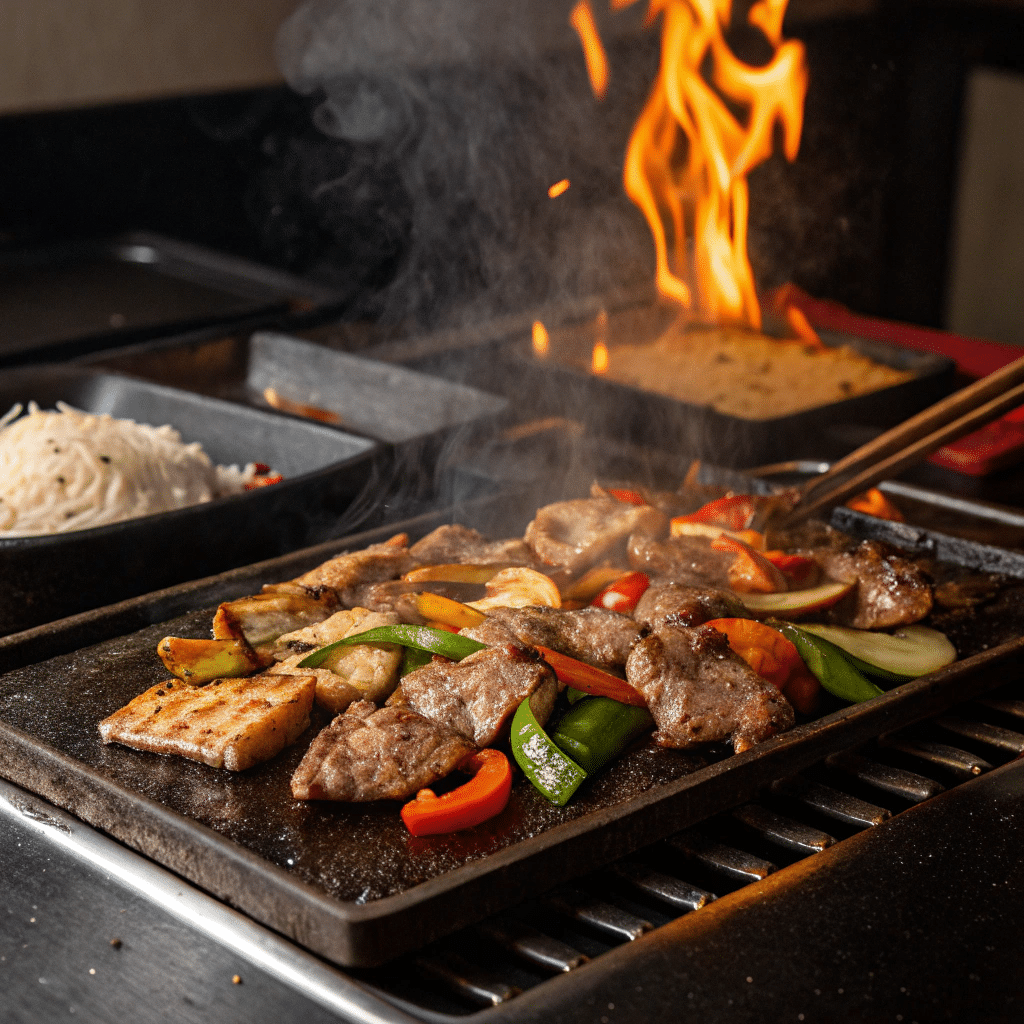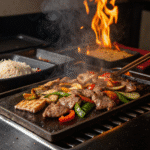Table of Contents
Table of Contents
Introduction
Hi, I’m Alice Thompson, the heart behind Deliciousavors.com. Growing up in Madison, Georgia, my fondest memories are of family and friends gathered in our kitchen, sharing laughter and good food. This hibachi recipe brings that same joy to your table, combining the excitement of restaurant-style cooking with the comfort of home. Whether you’re a beginner or experienced cook, I’m cheering you on as you create this delicious meal that brings people together.
I’ll never forget the first time I experienced a hibachi recipe come to life in front of me. My family and I were celebrating my college graduation at a Japanese steakhouse, and the chef’s knife skills were absolutely mesmerizing. But what really captured my heart was when he started cooking – the sizzle of the grill, the aroma of garlic butter, and the way everything came together in perfect harmony. That recipe experience sparked something in me that I carry into my own kitchen today.
Just like those treasured family gatherings we had in Madison, hibachi cooking brings people together around food that’s not just delicious, but also fun to make. Moreover, there’s something magical about recreating that restaurant experience at home, turning your kitchen into an interactive dining adventure. Therefore, I’m excited to share this complete hibachi recipe guide that’ll help you master the art of Japanese-style grilling right in your own kitchen.
PrintHibachi Recipe guide: 7 Secret Tips for best Results
Authentic hibachi recipe bringing Japanese steakhouse flavors to your home kitchen with perfectly seared proteins and vegetables
- Prep Time: PT0H20M
- Cook Time: PT0H25M
- Total Time: PT0H45M
- Yield: 4 servings
- Category: Main Course
- Method: Grilling
- Cuisine: Japanese
Ingredients
2 lbs mixed proteins (chicken breast, sirloin steak, shrimp)
2 zucchini, sliced into rounds
1 large onion, sliced
8 oz mushrooms, sliced
3 tbsp soy sauce
2 tbsp garlic butter
1 tbsp sesame oil
2 tbsp vegetable oil
Salt and pepper to taste
2 cups cooked rice
2 eggs for fried rice
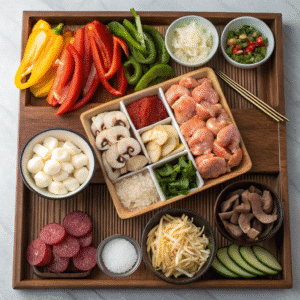
Instructions
Step 1: Heat griddle or large skillet to 400-450°F and add oil
Step 2: Cut proteins into bite-sized pieces and season with salt and pepper
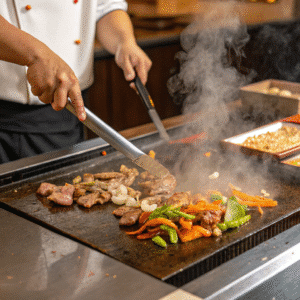
Step 3: Cook steak pieces 1-2 minutes per side, remove and keep warm
Step 4: Cook chicken pieces 2-3 minutes per side until golden brown
Step 5: Add shrimp and cook 1-2 minutes per side
Step 6: Cook vegetables 4-5 minutes, stirring occasionally
Step 7: Return all proteins to pan and toss with garlic butter, soy sauce, and sesame oil
Step 8: Make fried rice in same pan with eggs and cooked rice
Step 9: Serve immediately with hibachi sauces
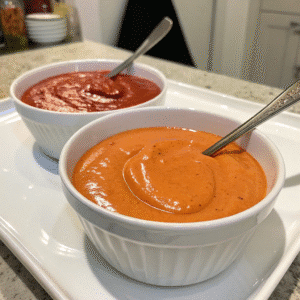
Notes
Use day-old rice for best fried rice texture
Cut all ingredients uniformly for even cooking
Keep cooking surface very hot throughout process
Prepare all ingredients before starting to cook
Essential Hibachi Recipe Ingredients and Equipment
Core Hibachi Recipe Components
The foundation of any great hibachi recipe starts with quality ingredients that work together to create those authentic flavors we all love. Furthermore, understanding these basic components will help you build confidence in your cooking skills.
Protein Selection: Your hibachi recipe success depends heavily on choosing the right proteins. Chicken breast and thighs work wonderfully because they cook quickly and absorb flavors beautifully. Additionally, sirloin steak cut into bite-sized pieces creates that perfect sear we’re after. Meanwhile, medium-sized shrimp add sweetness and cook in just minutes.
Seasoning Essentials: The secret to an authentic recipe lies in the seasoning blend. Salt, pepper, and garlic powder form the base, while soy sauce provides that essential umami depth. Similarly, fresh ginger adds warmth and complexity, and sesame oil brings that distinctive nutty flavor that makes hibachi so special. Additionally, butter plays a crucial role in creating that rich, restaurant-quality taste.
Equipment for Success
Creating the perfect hibachi recipe at home doesn’t require expensive equipment. A large cast-iron skillet or flat-top griddle works perfectly for achieving that high-heat sear. However, if you have a Blackstone griddle, you’ll find it makes the process even more authentic. Most importantly, having a good spatula set and sharp knife will make your recipe preparation much smoother.
| Equipment | Purpose | Alternative |
|---|---|---|
| Cast Iron Skillet | High-heat cooking and searing | Large non-stick skillet |
| Flat-top Griddle | Cooking multiple items simultaneously | Large wok or skillet |
| Metal Spatula Set | Flipping and moving food | Wooden spoon and tongs |
Mastering Hibachi Recipe Cooking Techniques
Temperature Control and Oil Selection
The key to any successful recipe lies in understanding heat management and choosing the right cooking oil. Professional chefs recommend oils with high smoke points for hibachi cooking. Specifically, avocado oil works best because it can handle temperatures up to 520°F without breaking down. Similarly, grapeseed oil and canola oil are excellent alternatives that provide neutral flavors.
Heat Management: Your recipe success depends on maintaining consistent high heat throughout the cooking process. Start by preheating your cooking surface to around 400-450°F. Additionally, this temperature creates that perfect sear while keeping the interior tender and juicy. Furthermore, having different heat zones allows you to cook various ingredients simultaneously without overcooking.
Oil Application: Apply oil directly to the cooking surface rather than to the food itself. Moreover, this technique prevents sticking and ensures even cooking. Additionally, using about 1-2 tablespoons of oil per cooking batch provides the perfect balance.
Perfecting the Sear
Creating the perfect sear is what separates a good hibachi recipe from a great one. First, make sure your protein is cut into uniform, bite-sized pieces. Next, season the pieces and let them rest for a few minutes before cooking. Then, place them on the hot surface and resist the urge to move them immediately. Finally, this allows the Maillard reaction to occur, creating that golden-brown crust we love.
Timing Guidelines: Chicken pieces typically need 2-3 minutes per side, while steak requires 1-2 minutes for medium-rare. Meanwhile, shrimp cook fastest at just 1-2 minutes per side. Additionally, vegetables need 4-5 minutes total, depending on their size and density.
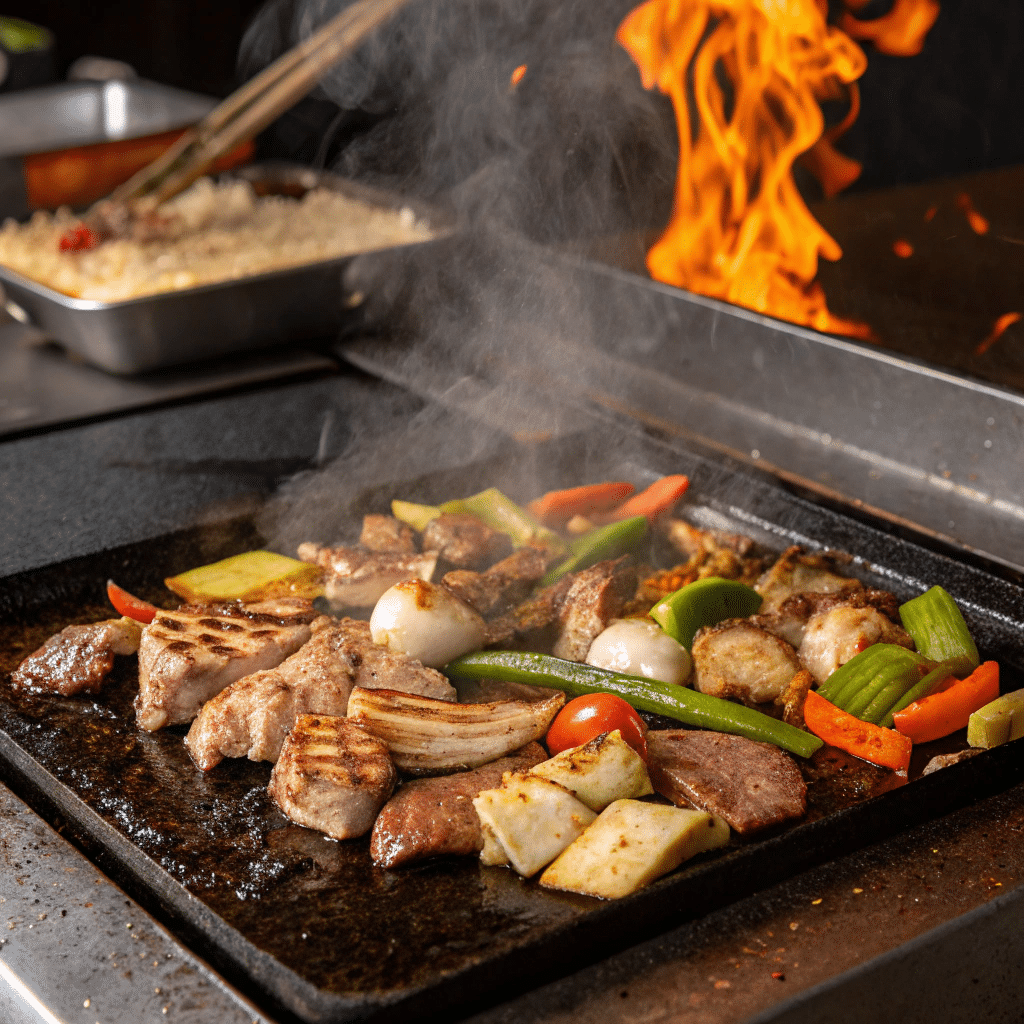
Complete Hibachi Recipe Instructions
Preparation Steps
Before you start cooking your recipe, proper preparation makes all the difference. Begin by cutting your proteins into uniform, bite-sized pieces – this ensures even cooking. Next, prepare your vegetables by cutting them into similar-sized pieces. Additionally, have all your seasonings and sauces ready because hibachi cooking moves quickly.
Protein Preparation: Cut chicken breast into 1-inch cubes and season with salt, pepper, and garlic powder. Similarly, cut steak into bite-sized pieces and season with your favorite hibachi seasoning blend. Meanwhile, clean and devein shrimp, then pat them dry for better searing.
Vegetable Preparation: Slice zucchini into thick rounds, cut onions into strips, and slice mushrooms uniformly. Additionally, having everything prepped and within reach makes the cooking process smooth and enjoyable.
Cooking Sequence
The secret to a successful recipe is cooking in the right order. Start with proteins that take the longest to cook, then move to quicker-cooking items. Furthermore, this timing ensures everything finishes at the same time.
Step-by-Step Process: Heat your cooking surface and add oil. First, cook the steak pieces for 1-2 minutes per side, then remove and keep warm. Next, cook chicken pieces for 2-3 minutes per side until golden brown. Then, add shrimp and cook for 1-2 minutes per side. Finally, cook vegetables for 4-5 minutes, stirring occasionally.
Finishing Touches: Once everything is cooked, return all proteins to the cooking surface and toss with butter, soy sauce, and sesame oil. Additionally, this final step brings all the flavors together and creates that authentic taste.
Hibachi Recipe Sauces and Accompaniments
Classic Hibachi Sauces
No hibachi recipe is complete without the iconic sauces that make the experience special. The two most popular sauces are Yum Yum sauce and ginger sauce. Furthermore, these sauces are surprisingly easy to make at home and taste even better than restaurant versions.
Yum Yum Sauce: This creamy, pink sauce combines mayonnaise, ketchup, sugar, garlic powder, and paprika. Additionally, a touch of rice vinegar adds brightness, while melted butter provides richness. Moreover, refrigerating the sauce overnight allows the flavors to meld perfectly.
Ginger Sauce: This brown, tangy sauce features fresh ginger, soy sauce, rice vinegar, and a touch of maple syrup. Similarly, adding minced garlic and onion creates depth and complexity. Additionally, this sauce pairs beautifully with both proteins and vegetables.
Hibachi Fried Rice
Fried rice is an essential component of any complete hibachi recipe. Start with day-old rice for the best texture, as fresh rice tends to be too moist. Additionally, the key to great hibachi fried rice is using garlic butter and soy sauce for authentic flavor.
Cooking Process: Heat oil in your pan and scramble eggs first, then push them to one side. Next, add cold rice and break up any clumps with your spatula. Then, add soy sauce, garlic butter, and sesame oil for flavor. Finally, stir in chopped green onions for freshness and color.
Frequently Asked Questions
What is the secret ingredient in hibachi?
What ingredients do I need for hibachi?
What seasoning do they use at hibachi?
Conclusion
Creating an authentic recipe at home brings the excitement and flavors of Japanese steakhouse dining right to your kitchen. Moreover, with the right ingredients, equipment, and techniques, you can master this impressive cooking style. Additionally, the interactive nature of hibachi cooking makes it perfect for entertaining family and friends.
Remember, the key to a successful recipe lies in preparation, high heat, and quality ingredients. Furthermore, don’t be afraid to experiment with different proteins and vegetables to make the recipe your own. Most importantly, have fun with the process – that’s what makes hibachi cooking so special.
For more recipes, visit my Facebook page.
